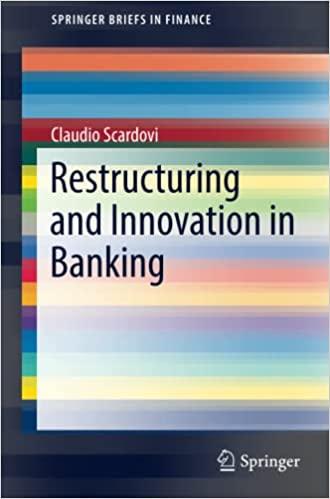Question
1. Revisit the asset allocation and funding source decisions you made in Round One in light of the outcome (1 through 7) provided by your
1. Revisit the asset allocation and funding source decisions you made in Round One in light of the outcome (1 through 7) provided by your instructor BELOW.
| Outcomes | Outcome Probability | Cash | One-Year U.S. Treasury Bills | Five-Year U.S. Treasury Notes | 15-Year U.S. Treasury Bonds Notes |
| 1 | 16.67% | No Change | No Change | No Change | No Change |
| 2 | 25 | No Change | 0.36% | 0.88% | 1.86% |
| 3 | 25 | No Change | 0.06% | 0.58% | 1.56% |
| 4 | 13.89 | No Change | No Change | 0.78% | 1.86% |
| 5 | 13.89 | No Change | No Change | 0.58% | 1.46% |
| 6 | 2.78 | No Change | 0.50% | 0.58% | 0.75% |
| 7 | 2.78 | No Change | 0.75% | 0.68% | 0.50% |
(Round 1/Asset Allocation)
| Balance Sheet t=0: Start of Round 1
| |||
| Assets | Liabilities and Shareholders Equity | ||
| Cash | $200,000 | Liabilities | $0 |
| One-Year Treasury Bills | $100,000 | Common Stock | $1,000,000 |
| Five-Year U.S. Treasury Notes | 400,000 | Retained Earnings | $0 |
| 15-Year U.S. Treasury Bonds | 200,000 | Total Shareholders Equity | $1,000,000 |
| Total Assets | $1,000,000 | Total Liabilities and Shareholders Equity | $1,000,000 |
2. Based on the actual outcome at the end of t=1 and assuming all notes and bonds initially traded at par, that is, the t=0 annual rate is the coupon rate, complete the following table:
| Round One Allocation in $ (a) | Annual Rates of Return t=0 (b) | Outcome Rates t=1 (c) | Interest Income t=1 (d) | Asset Valuation t=1 (e) | |||
| Cash | 0% | 0% | 0 | = a | |||
| One-Year U.S. T-Bills | 0.16% | = a x b | = a x (1+b) | ||||
| Five-Year U.S. T-Notes | 0.68% | = a x b | See Below | ||||
| 15-Year U.S. T- Bonds | 1.66% | = a x b | See Below | ||||
| Total | $1,000,000 | | | $ | $ |

3. Based on the totals above create a balance sheet at t=1. Assume no dividends, that is, all interest income is retained and that all retained earnings are held as cash.
Cash at t=1 equals Cash at t=0 plus total interest income for the period.
Securities at t=1 equal total Asset Valuation of Treasury securities at t=1.
Common Stock equals Common Stock at t=1.
Retained Earnings equal interest income in period 1 net of any gains or losses in Treasury securities.
| Balance Sheet t=1: End of Round 1 | ||||
| Assets | Liabilities and Shareholders Equity | |||
| Cash | Total Liabilities | $0 | ||
| Securities | Common Stock | $1,000,000 | ||
| Retained Earnings | ||||
| Total Shareholders Equity | ||||
| Total Assets | Total Liabilities and Shareholders Equity | |||
Of course, make sure Total Assets=Total Liabilities and Shareholders' Equity.
4. In a paragraph, discuss what caused the above changes to your bank's balance sheet.
Please let me know if the image adjustments made, based off the comments by others, were good enough to view everything. Thanks
Assuming coupon payment occur once each year, the values for the initial five-year T-Notes and 15-year T-Bonds at t-1 are calculated as follows Five-Year T-Note Value t-1 Obxa Fifteen-Year TBond Value t-1 (bxa) 1 c) 14 Assuming coupon payment occur once each year, the values for the initial five-year T-Notes and 15-year T-Bonds at t-1 are calculated as follows Five-Year T-Note Value t-1 Obxa Fifteen-Year TBond Value t-1 (bxa) 1 c) 14
Step by Step Solution
There are 3 Steps involved in it
Step: 1

Get Instant Access to Expert-Tailored Solutions
See step-by-step solutions with expert insights and AI powered tools for academic success
Step: 2

Step: 3

Ace Your Homework with AI
Get the answers you need in no time with our AI-driven, step-by-step assistance
Get Started


